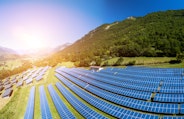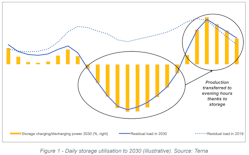
Italy’s appetite for energy storage seems to be growing by the month. The country is one of just a handful in Europe that includes energy storage in its national energy and climate plan, with a target of 6 GW of capacity by 2030.
This may sound like a lot, but based on recent events Italy could achieve that scale in a couple of years using distributed storage systems alone.
In the first quarter of 2023, the country saw 741 MW and 1 GWh of distributed storage being commissioned, according to the renewables trade body ANIE Rinnvabili. The capacity was spread across almost 80,200 storage systems, 99% of which were connected to solar arrays.
The fact that Italy is deploying such high levels of storage using systems with an average of 9 kW and 13 kWh of capacity is remarkable, likely only equalled by a couple of other markets in the world, such as Australia and Germany, where residential batteries have become a standard addition to PV.
Italy’s 2023 residential storage spree follows record levels of installations in 2022, when Italians connected 1.1 GW and 2 GWh of capacity. But it appears this is just a taste of things to come.
The analyst firm Wood Mackenzie is cited as forecasting that Italy could deploy 12.2 GWh of storage by 2031, making it the second-largest growth market in Europe, after the UK. And this figure is just a fraction of what Italy’s transmission system operator Terna believes it requires.
In August 2023, Terna said it would need almost 8.9 GW and 71 GWh of new grid-scale energy storage capacity by 2030 to meet European Union (EU) climate targets based on the integration of renewable energy sources (RES) into the grid.
This is roughly the same amount as Wood Mackenzie’s estimate for 2031 levels across all of Europe’s top nine energy storage markets combined—and would easily make Italy the biggest market in Europe, particularly if Terna’s estimate does not include distributed systems.
Terna’s energy capacity figures suggest the transmission system operator is looking for long-duration storage assets such as pumped hydro energy storage (PHES) as well as battery capacity.
Indeed, a report by Energy Storage News cites seven possible technologies: lithium-ion batteries, PHES, compressed air energy storage, non-lithium-ion electrochemical assets, power-to-gas plants, flywheels and electrostatic or magnetic systems.
However, Terna “did say that lithium-ion and PHES are the two main reference technologies because of their technological and commercial maturity and both ‘can offer the services required for the integration of renewables and the efficient operation of the electricity system’,” said the publication.
Terna’s report added: “The two identified reference technologies also have high efficiencies, of around 70-75% for pumped hydro and 80-90% for lithium batteries.
“The efficiency of a storage system is fundamentally important, as the use of low-efficiency technologies would lead to major system inefficiencies, and this would jeopardise the fulfilment of decarbonisation and RES integration targets,” it added.
Coming from the body that is tasked with keeping Italy’s lights on, Terna’s figures are not to be taken lightly. And some basic analysis shows why it is hedging its energy storage bets on the high side.
Like many European nations, and particularly those around the Mediterranean with abundant solar reserves, Italy is rushing to install high levels of PV power.
Between 2011 and 2022 it had Europe’s second-largest solar fleet, although utility-scale projects have suffered from permitting challenges that have led to a lacklustre response to national auction schemes.
The Italian Solar market is "flourishing"
Nevertheless, says European solar trade body SolarPower Europe, “Solar in Italy is finally back to the annual GW size for the first time since 2013, granting the Mediterranean country the sixth place in the EU.
“With an estimated 2.6 GW added capacity and a 174% year-on-year growth, the Italian market is flourishing,” said SolarPower Europe.
“The small-scale PV segment has bolstered the market, thanks to the country’s favourable Superbonus 110% incentive scheme, and high electricity prices which have improved the attractiveness of self-consumption business models.”
A consequence of this is the emergence of a so-called duck curve in daytime solar generation.
The duck curve, first noted in California and now arising in a range of solar-heavy grids worldwide, is a phenomenon whereby solar power dominates the generation mix in the middle of the day but falls off rapidly in the evening, forcing other technologies to ramp up and meet rising residential demand.

On traditional grids this ramp-up need is often met using gas peaker plants, which is hardly good for the environment or for electricity costs.
What Terna is aiming to do is use energy storage to soak up excess daytime solar generation and store it for use in the evening, meeting ramp-up requirements with low-cost, low-carbon electricity.
“Storage will make it possible to 'structurally' shift part of the production of variable renewable energy sources from the hours of high resource availability to the hours of low or no availability, managing their overgeneration efficiently,” says the Terna report.
Another feature of the Italian power market is that the country’s geographical location on a Mediterranean peninsula limits the grid interconnection capacity it can have with neighbouring nations.
This makes storage even more valuable, because there is only limited potential to export and import energy from abroad to deal with supply and demand mismatches.
This is one reason why the UK, which also has only limited interconnection capacity, has had such a vigorous energy storage market to date.
That said, all grids will have to deal with higher levels of solar and RES generation in future, so the capacity upgrades being seen in the Italian market could easily start cropping up elsewhere. Terna itself recognises that its current forecasts may be subject to change.
“The actual needs for new storage capacity to be procured by the new mechanism will have to be re-evaluated over time, taking into account the actual development and geographical location of RES in Italy,” it says.
For now, it is good news that Terna is being realistic about the amount of energy storage it may need. Other grid operators should take note.
Publish date: 28 March, 2024